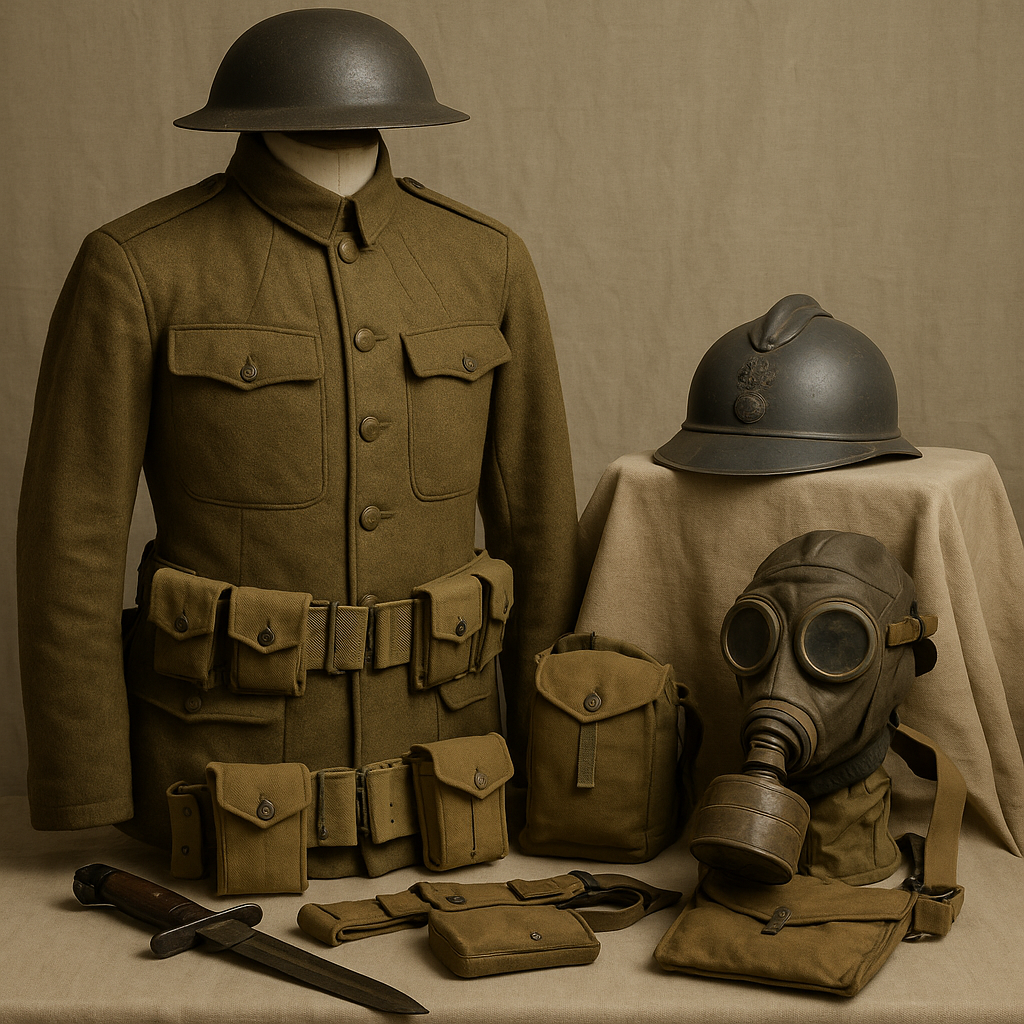
WW1 Uniform Parts and Accessories | Explore Authentic Military Gear
Published on May 11, 2025
WW1 Uniform Parts and Accessories: A Collector’s Guide to Historical Military Gear
Introduction: Why WW1 Uniforms Matter Today
World War I was a turning point in the design and utility of military uniforms. It marked the transition from traditional, decorative attire to rugged, practical battlefield gear. The demands of trench warfare, combined with technological advancements like chemical weapons, required uniforms that were protective, functional, and adaptable.
For collectors, reenactors, and military historians, WW1 uniforms are not just fabric and metal—they're stories woven into the very threads of global history.
1. A New Era of Military Uniforms
Before WWI, military uniforms were often designed with aesthetics in mind—bright colours, tall hats, and ornamental accessories. But by 1914, it became clear that such designs were liabilities in modern warfare.
Troops needed clothing that provided camouflage, warmth, and protection. Countries quickly adapted, developing uniforms that reflected the realities of trench fighting, constant exposure to the elements, and new warfare tactics.
2. Key Uniform Components from World War 1
a. Helmets
One of the most iconic symbols of WWI is the steel helmet. Prior to its introduction, many armies relied on cloth or leather headgear, offering little protection.
- Brodie Helmet (British & Commonwealth Forces): Characterized by its shallow dome and wide brim, it was designed to protect against shrapnel.
- M1917 Helmet (U.S. Army): A near-identical version of the British Brodie, used widely by American forces.
- Adrian Helmet (French and Italian Forces): Recognizable by its crest, it was among the first steel combat helmets of the 20th century and was also adopted by the Italian army during the war.
Helmets evolved not only for protection but also as tools for identification through unit badges and paint designs.
b. Tunics and Jackets
The tunic served as both uniform and utility. Wool was the primary material due to its warmth and durability.
- British Service Dress Tunic: Practical design with four pockets and reinforced shoulder straps.
- U.S. M1912 and M1917 Tunics: Featured a high collar and were designed for both dress and field use.
- French and Italian Field Jackets: Tended to be simpler but just as durable, designed for layered use with overcoats.
c. Trousers and Leggings
Soldiers wore breeches or straight-cut trousers, often paired with puttees—long cloth strips wrapped around the lower leg for ankle support and added warmth.
These garments provided flexibility and some protection from mud and debris in the trenches.
d. Boots and Footwear
Footwear was perhaps the most abused part of a soldier’s uniform. Trench conditions were harsh—mud, water, and freezing temperatures demanded tough, high-quality boots.
- British Ammunition Boots and U.S. Trench Boots were standard issues.
- Waterproofing was often a concern, leading to improvements in sole construction and boot oiling.
3. Essential Accessories and Equipment
Uniforms extended beyond basic clothing. Accessories were vital for survival, communication, and combat readiness.
a. Webbing Gear
Webbing systems like the British 1908 Pattern and the U.S. M1910 provided soldiers with ways to carry ammunition, bayonets, rations, and personal items.
The webbing layout could be adjusted depending on a soldier’s role—rifleman, machine gunner, or officer.
b. Gas Masks
Chemical warfare was a new and terrifying innovation during WW1. Soldiers were issued rudimentary gas masks early on, which evolved into more sophisticated filter-based designs by the war’s end.
c. Entrenching Tools
Short spades and pickaxes were essential for digging trenches or defensive positions. Many were designed to be used in close-quarters combat when needed.
d. Identification Tags
Dog tags were introduced during WW1 to help identify the dead or wounded. Typically made of aluminium or zinc, these simple tags carried a soldier’s name, number, and unit.
4. Collecting WW1 Uniform Parts Today
For collectors and history enthusiasts, WW1 gear holds immense historical value. Whether you’re acquiring pieces for a private collection, a reenactment group, or an educational display, it’s important to distinguish between original items and reproductions.
Key tips when collecting WW1 uniform parts:
- Condition and Authenticity: Look for manufacturer stamps, period wear, and military markings.
- Material Checks: Genuine WW1 uniforms often used heavy wool, brass fittings, and real leather.
- Documentation: Provenance can add value to any item. Try to get background information when possible.
Websites like Paddelaters.com specialize in curated collections of WW1 helmets, uniforms, and accessories that blend authenticity with accessibility.
5. Connecting to WW2 Gear and Evolution
While the article focuses on WW1, it's important to acknowledge how the lessons of that war shaped the gear used in WW2. The transition from decorative uniforms to practical military gear was complete by the 1940s.
Collectors often bridge both eras, exploring WW1 and WW2 gear for sale to see how military technology and tactics evolved.
Conclusion
WW1 uniform parts and accessories are more than relics—they are echoes of the past that offer invaluable insights into the lives of soldiers and the nature of early 20th-century warfare. Every tunic, helmet, and gas mask tells a story.
Whether you're a collector, reenactor, or educator, understanding and preserving these items ensures that the legacy of the Great War remains alive for future generations. At Paddelaters.com, our commitment is to provide you with high-quality, historically accurate gear that honours this important history.
